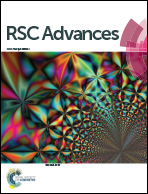Improving the mechanical properties of cellulose diacetate fibers via using an ionic liquid as processing solvent†
Abstract
The solutions of cellulose diacetates (CDA) in ionic liquids, 1-butyl-3-methylimidazolium chloride ([BMIM]Cl), 1-butyl-3-methylimidazolium tetrafluoroborate ([BMIM]BF4), 1-butyl-3-methylimidazolium hexafluorophosphate ([BMIM]PF6) and 1-butyl-3-methylimidazolium formate ([BMIM]COOH), have been investigated to identify the solvent for optimal CDA fiber performance. The CDA/[BMIM]Cl and CDA/[BMIM]BF4 solutions both behave as typical shear-thinning fluids that are beneficial for fiber spinning. The CDA/[BMIM]Cl solution exhibits higher flowability and spinnability than the CDA/[BMIM]BF4 solution. CDA fibers with compact morphology and smooth surface have been fabricated from the [BMIM]Cl solution. The tensile strength of the resulting CDA fibers (3.00 cN per dtex) is significantly improved over that of commercial CDA fibers (1.44 cN per dtex), even when the commercial fibers (3.83 dtex) are thinner than the new CDA fibers (5.20 dtex). The present method to fabricate CDA fibers with improved mechanical properties can be directly used for the production of fabric yarns and garments.


 Please wait while we load your content...
Please wait while we load your content...